
Watching the balance on your savings account climb higher and higher is undeniably a deeply satisfying feeling, but there absolutely is such a thing as “having too much cash.” Piling stacks on stacks might feel great, but letting too much of your money sit there and gather dust is almost never the best strategy — even if “gathering dust” means earning more in a high-yield account.
Your money should be working for you, whether you’re building an emergency fund, saving for a big purchase like a car or wedding, or getting ready to invest.
You probably already know that, generally speaking, investing is a crucial part of any financial plan, no matter what your net worth right now. (Investing: not just for rich people!) Maybe you don’t tend to think of yourself as the “type of person who invests” — maybe you still have debt, are working on saving for your short-term financial goals; maybe you’re barely contributing to your company 401(k) and even that feels taxing on your budget at the moment. We totally feel you.
But here’s the key: Try thinking about your current financial condition as one moment on a longer financial evolution, as opposed to a fixed state in which you’ll remain indefinitely. What’s happening in our lives right now can so easily consume our minds, but life comes at you fast, and you don’t want to be standing in the middle of your financial future before you start giving any thought to what you’ll do to make the most of your money once you’re there.
Think about it: What do things look like for you further along in your financial development? What happens in a few years when you’re in a more senior place in your career? What about when your debts are paid down? What happens if you pick up a partner along the way and then have two incomes to work with?
When we say “you should think about investing,” we don’t mean you should take every dollar in your bank account that isn’t going toward rent, bills, and food and throw it all into a diversified portfolio tomorrow. We mean you should think about your whole, long-term financial strategy — beyond just the tactics you’re using today to make your money work in the present — and make investing a part of it, even if right now isn’t the moment to act on that part.
So, what exactly should you do with your cash in the meantime? How much cash should you hang onto? Long story short: Your checking account shouldn’t hold more than you need to cover your monthly expenses. While you’re still working on building and maintaining the liquidity you need right now, here’s how you can (and should) do so while thinking like an investor.
First things first: Emergency Savings
You certainly already know this, but we’ll never pass up a chance to reiterate this: Build your emergency fund before you do anything else. Life is stressful enough — there’s no overvaluing the peace of mind you’ll get from knowing that you’re covered just in case. No smart investment strategy doesn’t include having a cushion of easily accessible cash.
Wondering what that looks like? We’ve got you covered: we laid out exactly how to figure out the right emergency fund for you. It’s so important to try to always have enough money to cover living expenses for three to six months, especially if you freelance or have unsteady paychecks. This cash reserve can also save the day when unexpected bills come up (unfortunately, you can’t always plan for healthcare costs, a leaky roof, or car troubles) or you have a few months between jobs.
Dealing with debts
So let’s say you have your emergency cash stash adequately funded — what’s the next task to tackle for an investment-minded saver? If you have debts weighing on your mind, it can be tempting to just throw chunks of cash at your largest outstanding balance, just do whatever you can, as fast as you can, to make the number less scary. Sometimes this is a good way to go, but not always. Depending on the interest rates associated with your debts, opting to invest extra cash, instead of paying down more on a lower-interest loan, could actually save you more in the long run.
Here’s our rule of thumb: pay off high-interest debts with an after-tax interest rate that is higher than the likely gains on an investment. Credit cards tend to have higher interest rates, whereas some student loans will have lower interest rates than the likely returns on an investment. Take a look at your specific debts and go from there.
Now, with emergency savings stocked away and a plan figured out for dealing with whatever debt you have, let’s talk about where to actually put your money.
What to do with short-term savings
Everyone needs liquid assets, that is, cash or assets that can be quickly converted to cash. Some of that needs to live in your checking account. Think of your checking account as a train that takes your cash from point A to point B, and that’s it. It’s where your paycheck comes in and where you take out money for your rent, bills, loan and credit card payment, and all other predictable, recurring expenses, plus whatever cash and debit card spending you’ll do and maybe a small amount of extra cushion in case one of those expected costs is ever a bit higher than normal. Fin. That’s all. That’s what a checking account is for.
Once you get beyond the amount you need for that routine spending, though, cash that’s left sitting in your checking account becomes lazy. For all the cash you don’t need this month but expect to need in the next three to five years, your cash is better off out of your checking account. It should be earning interest in a high-yield cash account, like the Wealthfront Cash Account. (Not to brag, but ours not only has a high APY but also up to $1 million FDIC insurance, unlimited transfers, and no fees.) While we’re at it, this account is also the perfect place to keep your emergency fund, since you can easily withdraw money when needed, and since Wealthfront is not a bank, you’re not limited to six withdrawals a month like you are with bank savings accounts.
The same is true for money you’re saving for a big purchase you intend to make in the next few years, like a down payment on a house. Locking up your cash in investments that you’ll need in the next few years is risky, but that doesn’t mean it has to sit in your old bank’s savings account earning no interest for you while making money for your bank.
What to do with long-term savings
So where’s the line between cash you need to keep liquid and what you should invest? Glad you asked! We’ll tell you imprecisely where that line is: savings you won’t need in the next three to five years should be invested. Whether your precise line is closer to three years or five is a matter of your personal risk tolerance.
Feel a little anxious about making more of your money a little harder to access? Draw your “save vs invest” line a little further out, closer to five years. Feeling super confident and not interested in losing any scrap of potential gains? Draw a hard line at three years, and invest anything you don’t plan to spend within that window.
And that’s how you save your cash like an investor, even before you start investing at all.
Until then, the point isn’t just to put every available cent into whatever kind of account promises the highest returns. That’s what a literal baby would do if you explained interest rates to them and gave them control over your finances. What a growth-oriented adult would do is exactly what you’re doing: putting the exact right amount of cash in the optimal places at the ideal time. Whether that means you’re actively investing now or still laying your cash foundation that will launch your investments down the road, this is how you kill it.
![]()












